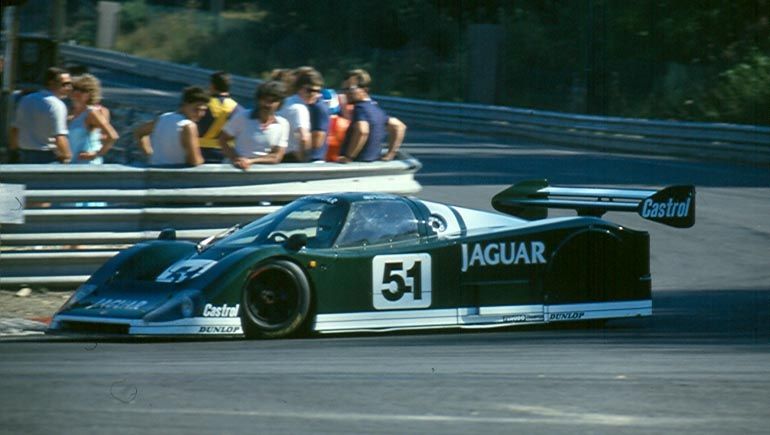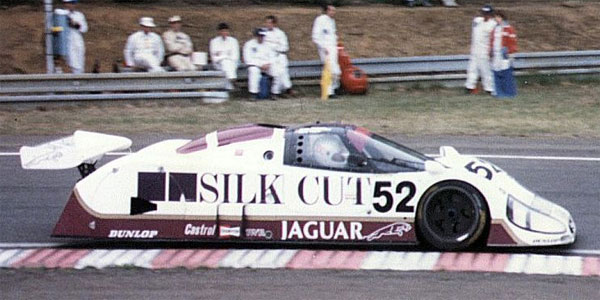|
|
23202 view(s)  In the early 1980s two of the most successful Jaguar privateers made plans to bring the marque back to Le Mans. In the early 1980s two of the most successful Jaguar privateers made plans to bring the marque back to Le Mans.
Both Bob Tullius' US based Group 44 and Tom Walkinshaw's Britain based TWR had vast experience with the latest version of Jaguar's V12 and felt it could be a strong competitor in the newly created Group C class.
This would mean taking on the mighty Porsches and that seemed virtually impossible without some structural factory support.
Surprisingly this was granted to both teams with Group 44 continuing to focus on the American IMSA GTP Championship and TWR on the Group C World Championship. This strategy would give Jaguar two chances at Le Mans glory.
Group 44 had a clear head start as their mid-engined Jaguar XJR-5 was ready late in 1982. The car sported an aluminum monocoque and used the Jaguar V12 engine as a fully stressed member.
The XJR-5 raced at Le Mans with factory backing at Le Mans in 1984 and 1985, with a class victory in the second year as a highlight. There was little chance of an overall victory, so Jaguar's focus was now turned to TWR's project.
 Other than using a similar engine, TWR's XJR-6 had little in common with the 'American' XJR-5. Tony Southgate was responsible for the design and applied many lessons learned in the abandoned Ford C100 racer. He laid out a carbon fibre monocoque and a highly advanced aerodynamics package with very large ground effects tunnels. It was quite a departure from the norm and would form the mould of all subsequently designed Group C racers. In conjunction with Zytek, TWR developed a fuel injection system of their own for the V12 engine. Their goal was to draw as much power from the engine with enough efficiency to meet the strict Group C fuel restrictions. Displacing 6.2 litres, the naturally aspirated engine produced around 650 bhp in endurance trim. Other than using a similar engine, TWR's XJR-6 had little in common with the 'American' XJR-5. Tony Southgate was responsible for the design and applied many lessons learned in the abandoned Ford C100 racer. He laid out a carbon fibre monocoque and a highly advanced aerodynamics package with very large ground effects tunnels. It was quite a departure from the norm and would form the mould of all subsequently designed Group C racers. In conjunction with Zytek, TWR developed a fuel injection system of their own for the V12 engine. Their goal was to draw as much power from the engine with enough efficiency to meet the strict Group C fuel restrictions. Displacing 6.2 litres, the naturally aspirated engine produced around 650 bhp in endurance trim.
The carbonfibre, monocoque, TWR Jaguars were common knowledge for much of 1985, but didn't actually appear until the tragic Mosport Park race in Canada (in which Manfred Winkelhock was killed). The British Racing Green Jaguar XJR6s ran well and scored a 3rd place finish for Schlesser, Brundle and New Zealander, Mike Thackwell.  One of the early problems was the XJR-6's high weight, which also meant the engine could not be run at full power to preserve fuel. One of the early problems was the XJR-6's high weight, which also meant the engine could not be run at full power to preserve fuel.
For 1986 Walkinshaw had secured abcking from Brtitsh Tabaco brand Silk Cut. Another three cars were built over the winter and prepared for the TWR's first full season in Group C, now know as Silk Cut Jaguar. Immediately, but it soon became clear that the improved XJR-6 was a threat to the formerly dominant Porsches. Eddie Cheever and Derek Warwick scored the XJR6's first 1000km victory at Silverstone. Thisn was a clear boost to the moral and hopes were high for the following round, the Le Mans 24hrs. Sporting low drag "longtail" bodywork 3 cars were presented at the Place des Jacobins. However the grueling demands of a full 24hrs sees all three cars failing to reach the finish. On Sunday morning, the#52 is 2nd position when a rear tire blowout breaks the suspension and the transmission.The two others cars are withdrawn earlier, #52 suffers engine failure through shortage of petrol and the #53 with a transmission problems. Proving that a Le Mans victory was still a bridge too far.
Sources:Wouter Melissen, www.ultimatecarpage.com | 24 heures du Mans 1987, editions Acla |The rise and fall of Group C
|
Models for Jaguar XJR 6
 |
| Manufacturer |
Model |
Scale |
Dimensions (LxWxH) |
Wheelbase |
Front spur |
Rear spur |
| Profil 24 |
Silk Cut #51-53 LM86 |
1/24 |
0.0x0.0x0.0 |
0.0 |
0.0 |
0.0 |
|

